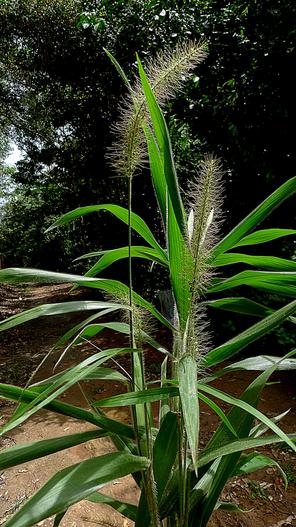Plains Bristlegrass
(Setaria vulpiseta)
Plains Bristlegrass (Setaria vulpiseta)
/
/

Alex Popovkin
CC BY 2.0
Image By:
Alex Popovkin
Recorded By:
Copyright:
CC BY 2.0
Copyright Notice:
Photo by: Alex Popovkin | License Type: CC BY 2.0 | License URL: https://creativecommons.org/licenses/by/2.0 | Uploader: Josve05a | Publisher: Wikipedia Commons










Estimated Native Range
Summary
Setaria vulpiseta, commonly known as plains bristlegrass, is a perennial grass native to a variety of habitats including open woodlands, grasslands, and along waterways in Texas, Colorado, Arizona, and northern and central Mexico. It typically grows to a height of 3-4 feet with a similar spread and features hairy leaves that can reach up to 10 inches in length. The inflorescence is a distinctive narrow, yellow bristle-like spike that can be up to 5 inches long, appearing in late summer to early fall. Plains bristlegrass is not particularly showy, but its texture and form can add interest to naturalistic plantings.
Plains bristlegrass is valued for its adaptability to a range of soil types, from well-drained sandy soils to heavier clay loams. It is drought-tolerant once established, making it suitable for xeriscaping and restoration projects. It can be used for erosion control and as a forage grass in pastures. In cultivation, it requires full sun to part shade and can tolerate a variety of moisture levels. While not commonly grown in ornamental gardens, it can be used in prairie-style plantings or as a component of wildlife-friendly landscapes. Caution is advised when planting outside its native range, as it can become invasive in some regions.CC BY-SA 4.0
Plains bristlegrass is valued for its adaptability to a range of soil types, from well-drained sandy soils to heavier clay loams. It is drought-tolerant once established, making it suitable for xeriscaping and restoration projects. It can be used for erosion control and as a forage grass in pastures. In cultivation, it requires full sun to part shade and can tolerate a variety of moisture levels. While not commonly grown in ornamental gardens, it can be used in prairie-style plantings or as a component of wildlife-friendly landscapes. Caution is advised when planting outside its native range, as it can become invasive in some regions.CC BY-SA 4.0
Plant Description
- Plant Type: Grass
- Height: 1-3 feet
- Width: 1-2 feet
- Growth Rate: Moderate
- Flower Color: N/A
- Flowering Season: Spring, Summer, Fall
- Leaf Retention: Deciduous
Growth Requirements
- Sun: Full Sun, Part Shade
- Water: Medium
- Drainage: Fast, Medium, Slow
Common Uses
Erosion Control, Low Maintenance
Natural Habitat
Open woodlands, grasslands, and along waterways in Texas, Colorado, Arizona, and northern and central Mexico
Other Names
Common Names: Foxtail Bristle Grass, Foxtail Millet
Scientific Names: , Setaria vulpiseta, Chaetochloa amplifolia, Chaetochloa composita, Chaetochloa trichorhachis, Chaetochloa vulpiseta, Chamaeraphis composita, Chamaeraphis setosa var. vulpiseta, Panicum amplifolium, Panicum compositum
GBIF Accepted Name: